How to Write Calligraphy With a Mechanical Pencil
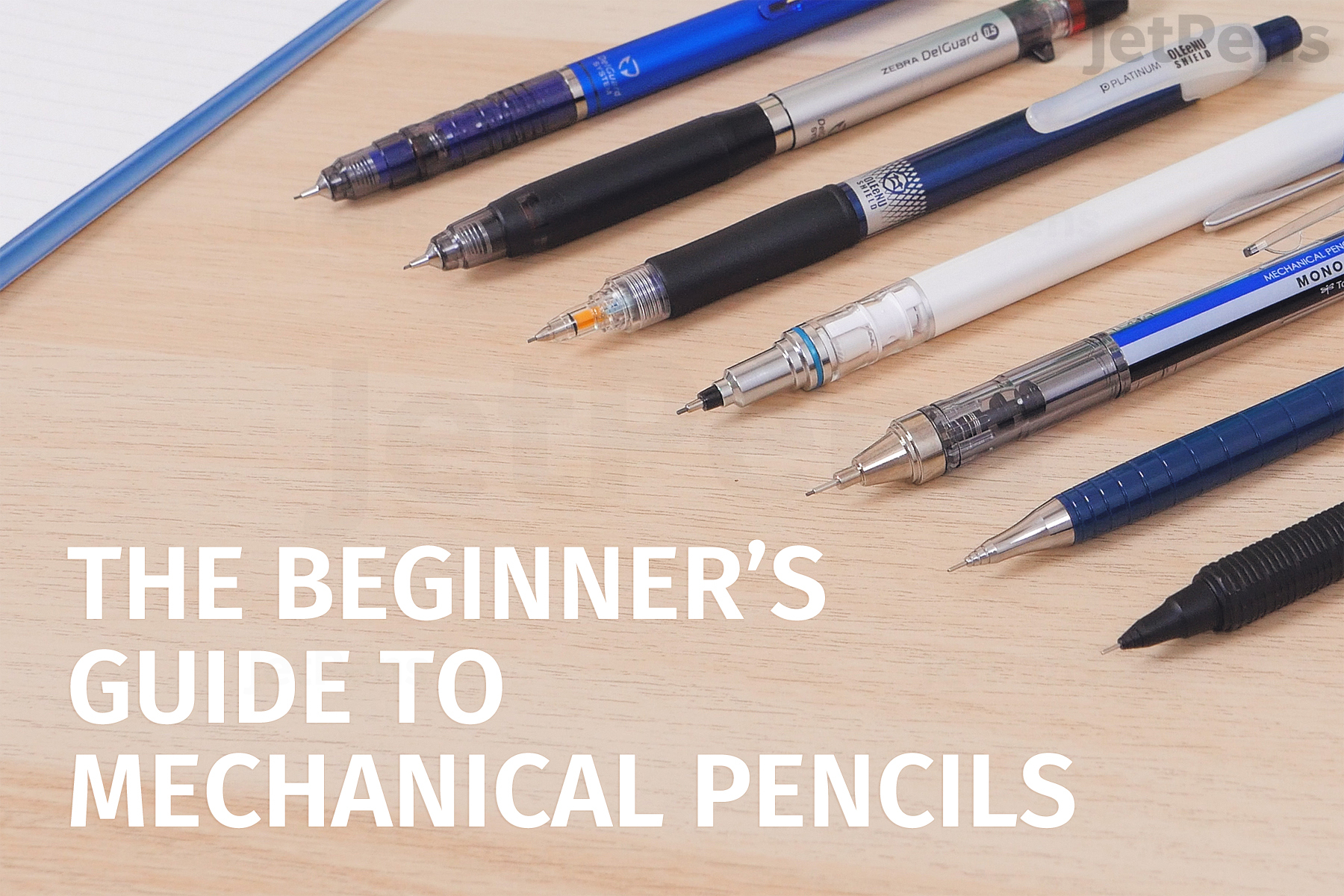
Did you know that mechanical pencils actually predate wooden pencils? Before people figured out how to make wood-cased pencils, refillable lead holders were used as the world's first pencils. Five centuries of refinement and innovation later, the world today is filled with a fantastic variety of fun and functional mechanical pencils to choose from.
In this guide, we'll explore the basics of what mechanical pencils are, why you should use them, how to use them, and how to troubleshoot the most common mechanical pencil problems.
Table of Contents
- What Is a Mechanical Pencil?
- Advantages of Using a Mechanical Pencil
- Using a Mechanical Pencil
- Extending the Lead
- Retracting the Lead
- Refilling the Lead
- Using the Eraser
- Replacing the Eraser
- Retracting the Lead Sleeve
- Troubleshooting
- The Lead Keeps Sliding Back Into the Pencil
- The Lead Won't Extend
- The Lead Keeps Breaking When You Extend It
- The Lead Keeps Breaking When You Write
- Finding Lead for Vintage Mechanical Pencils
- How We Approach Research and Testing
- Final Thoughts
What Is a Mechanical Pencil?
Mechanical pencils (sometimes called automatic or propelling pencils) are reusable holders that use thin sticks of graphite "lead" and include a mechanism for extending the lead—usually a push button. Mechanical pencil leads come in a variety of sizes, with 0.5 and 0.7 mm being the most common. Some mechanical pencils use leads that are 2 mm or wider, but these are generally categorized separately as "lead holders."
Another subtype of mechanical pencil that is often categorized separately is the drafting pencil. Drafting pencils are mechanical pencils with industrial features like extra-rugged construction, knurled grip sections, and lead grade indicators.
Advantages of Using a Mechanical Pencil
Mechanical pencils have a number of advantages over both wooden pencils and pens:
| Advantages of Mechanical Pencils... | |
|---|---|
Over Wooden Pencils:
| Over Pens:
|
Using a Mechanical Pencil
Extending the Lead
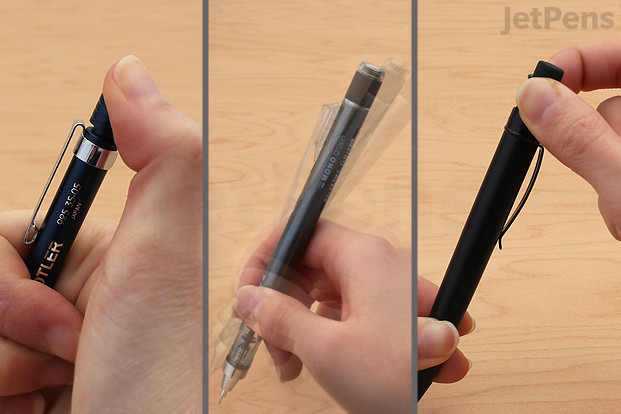
All mechanical pencils include some mechanism that lets you extend the lead out from the tip as it wears down. Here are the most common:
- Push Button—Most mechanical pencils have a button that extends a set amount of lead every time you push it. The button is usually located at the top end of the pencil (where the eraser typically is), but some pencils have the button on their side or even in their clip.
- Shaker—Some mechanical pencils have a clever mechanism that lets you extend the lead by simply shaking the pencil up and down. When you do, a sliding weight inside the pencil strikes a button inside the pencil that extends the lead for you. Virtually every shaker pencil also includes a conventional push button that you can use instead.
- Twist—Some mechanical pencils, especially ones inspired by vintage designs, let you extend the lead by twisting either the nose cone of the pencil or a knob at the top end of the pencil. Twist pencils let you decide exactly how much lead you want to extend, but they typically can only hold one lead at a time.
There are also more exotic and unusual mechanisms that some pencils use to extend the lead, like bending the pencil at a special joint. There are even pencils that extend the lead automatically without you needing to do anything at all!
Retracting the Lead
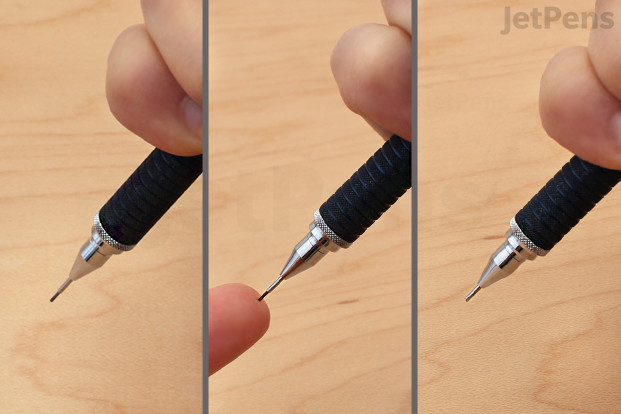
Sometimes you'll need to retract the lead, either because you accidentally extended too much lead or because you are done using the pencil for now and don't want the lead to break when you put it back in your pencil case.
For push button and shaker mechanical pencils, simply hold the push button down and push the lead back into the tip.
For twist mechanical pencils, twist the top knob or nose cone of the pencil in the opposite direction that you twist it to extend the lead. Some twist pencils will retract the lead for you when you do this, but with others you will need to push the lead back into the tip yourself after twisting.
Refilling the Lead
Sooner or later, all of the lead in your pencil will get used up and you will need to refill the pencil with more lead.
Picking the Right Leads
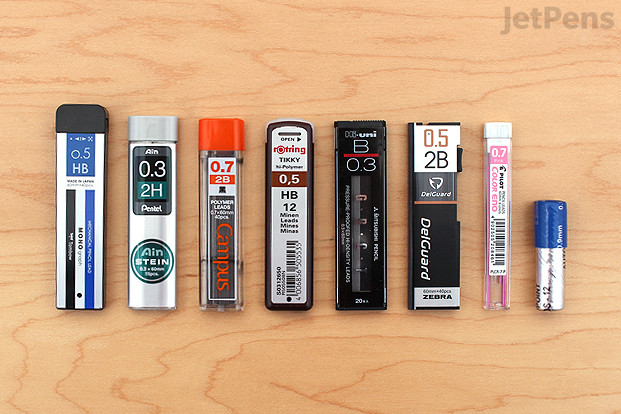
The most important thing is to make sure that the leads you are refilling the pencil with are the same size as the leads that the pencil came with. Many pencils have the lead size printed right on them, and we include the lead size that all of our pencils need in their product names. If you use leads that are too narrow, the leads will just fall out of the pencil tip when you try to extend them. If you use leads that are too wide, the leads will get jammed inside the pencil and clog it.
The next thing to consider is lead grade. By far the most commonly used grade is HB, which is equivalent to an American #2 pencil. If you want something a little bit darker and smoother, we recommend using B or 2B lead.
The last thing to consider is the brand and product line of the lead. Lead brand has much less impact on your writing experience than lead size and grade, but it does make a difference. You can read our guide comparing the different brands and lines of lead here.
Installing the Lead
Most push button mechanical pencils are refilled the same way:
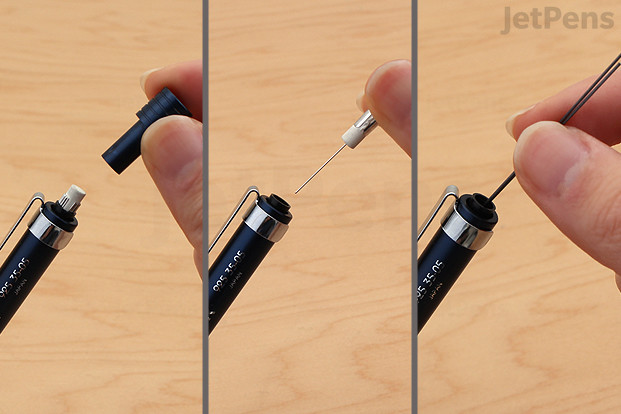
- Pull off the top cap or push button. It may be a cap covering the eraser, a piece of plastic that the eraser is attached to, or the eraser itself.
- If the top push button was a cap covering the eraser, pull out the eraser as well.
- Add 3-5 leads into the body of the pencil (AKA "the lead storage tube"). Don't fill the pencil with all the leads that will fit—it's tempting, but you'll wind up getting a lead jam.
- Put the eraser and/or top push button back into place.
- Click the push button until the new lead starts to come out.
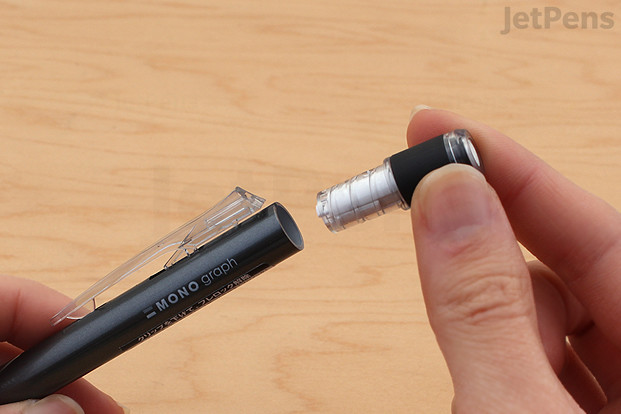
With some mechanical pencils, you'll need to remove a larger top section of the pencil. This is most common with shaker pencils, twist-erase pencils, and other pencils where a whole top section of the pencil acts as the push button.
Unlike push button pencils, most Twist mechanical pencils are refilled through the tip of the pencil:
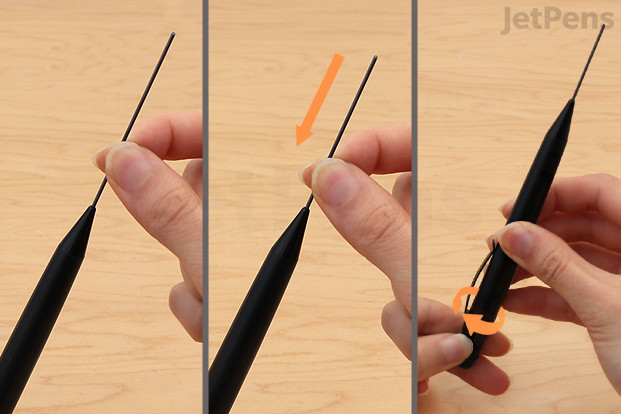
- Pull any remaining old lead out of the tip of the pencil.
- Insert the new lead into the tip of the pencil.
- For some pencils, you will need to press the new lead into the pencil until you feel it slide securely into the pencil's inner clutch mechanism.
- Retract the new lead back into the pencil by twisting the top or nose of the pencil.
Multi pen mechanical pencil components are a bit more complicated to refill. Check out our guide here for the details.
Using the Eraser
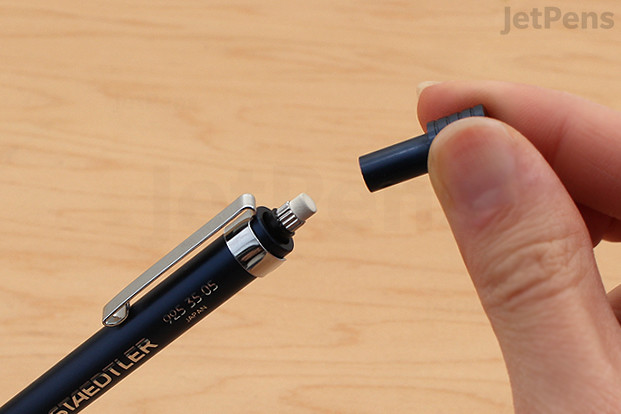
Most mechanical pencils have an eraser built into the top end. Often, the eraser is hidden under the top cap or push button, which can be pulled off to expose the eraser. Some pencils have twist erasers that can be extended or retracted by twisting the top end of the pencil.
Replacing the Eraser
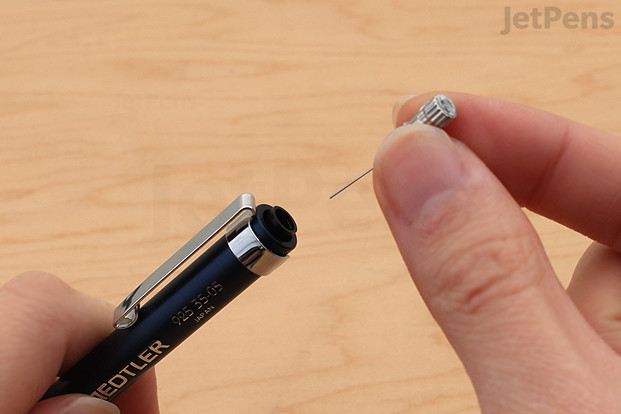
To replace most mechanical pencil erasers, simply pull the old one out and insert a new one in its place. Make sure to get the right refill erasers for your pencil—we list compatible erasers for all of our mechanical pencils under their Recommended Refills/Parts links.
Retracting the Lead Sleeve
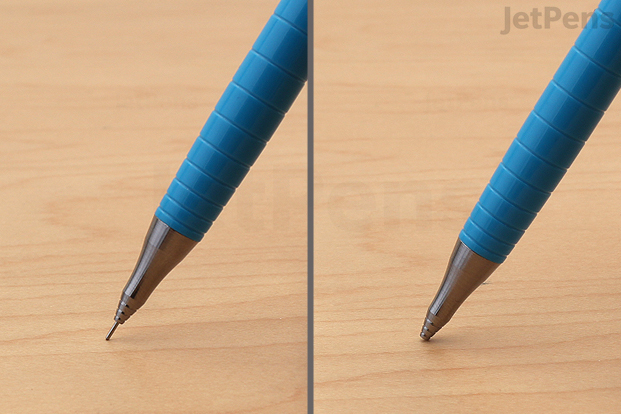
Some pencils let you retract the lead sleeve when you're not using the pencil. This protects the lead sleeve from getting bent, and it also protects your pocket or pencil case from getting poked by the lead sleeve. Most retractable lead sleeves can be retracted using the following steps.
- Hold down the pencil's push button.
- Press the tip of the lead sleeve against your finger or a hard surface.
- Release the push button while still pressing the tip of the lead sleeve.
As you release the push button, you will be able to push the lead sleeve back into the tip of the pencil. The lead sleeve will pop back out automatically the next time you click the push button.
Troubleshooting
Here are some tips for the most common issues we encounter when using a mechanical pencil.
The Lead Keeps Sliding Back Into the Pencil
If the lead keeps pushing back into the pencil whenever you press the tip down on the paper, the lead in the tip is too short and needs to be removed. Pull the lead out of the tip and keep clicking the push button until a new lead comes out. You may have to repeat this process if a piece of lead inside the pencil got broken into multiple small pieces.
The Lead Won't Extend
If the lead won't extend at all when you use the push button, try the following solutions:
- Make sure that you are using the right size lead for your pencil.
- Hold your pencil straight up and down and shake it gently. This can help get any leads stuck in the barrel to fall down into the pencil's clutch mechanism.
- Check your pencil for a lead jam. A lead jam happens when a bit of broken lead gets stuck inside the pencil and blocks new lead from coming out. You can read our guide to clearing lead jams here.
The Lead Keeps Breaking When You Extend It
If the push button works but the lead keeps breaking as you extend it, your pencil might have a partial lead jam.
If it's not a lead jam, then it may be that the pencil's lead sleeve is slightly bent. You can try to straighten it, but unfortunately you'll probably need to replace the pencil.
The Lead Keeps Breaking When You Write
If the lead keeps breaking when you write, there are a few things you can do:
- Use a more break-resistant lead. Pentel Ain Stein, Uni NanoDia, and Pilot Neox graphite leads are our top recommendations. Avoid using colored leads, since they are much more fragile than graphite leads.
- Use a slightly harder lead grade.
- Use a wider lead size.
- Use a pencil with built-in lead guarding features.
Finding Lead for Vintage Mechanical Pencils
Mechanical pencils made in the early to mid 20th century typically used 0.9 mm or 1.1 mm leads. Note that 1.1 mm leads are sometimes called 1.15 mm or 1.18 mm, but they are all interchangeable. Similarly, 1.0 mm leads are typically interchangeable with 0.9 mm leads. One trick to telling which size lead a pencil uses is to try inserting a bent paper clip into the tip. A standard jumbo (1 3/4") paperclip is just the right size to fit into a 1.1 mm pencil tip, and a standard no.1 (1 3/8") paper clip is just the right size to fit into a 0.9 mm pencil tip.
More recently made mechanical pencils may use any lead size, but the most common are 0.5 mm and 0.7 mm. If you have both lead sizes on hand, we recommend testing the 0.5 mm leads first, since putting 0.5 mm leads into a 0.7 mm pencil is less likely to cause problems than putting 0.7 mm leads into a 0.5 mm pencil.
Our writers draw on their personal expertise, consult our in-house subject matter experts, and do extensive research to make our guides as accurate and comprehensive as possible. We then test every finding that makes it through the research stage. Only the techniques and tools whose performance we personally confirm make it into our guides as recommendations.
Final Thoughts
Now that you know how to use a mechanical pencil and troubleshoot the most common issues that can crop up with them, be sure to take a look at our guide to the best mechanical pencils. We share some of our top recommendations and advice on how to choose the mechanical pencil that's right for you.
Do you have any mechanical pencil related questions that weren't answered here? Feel free to contact us or leave a comment below!
Related Posts
How to Write Calligraphy With a Mechanical Pencil
Source: https://www.jetpens.com/blog/The-Beginner-s-Guide-to-Mechanical-Pencils/pt/957
0 Response to "How to Write Calligraphy With a Mechanical Pencil"
Post a Comment